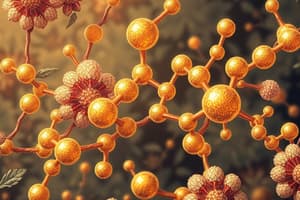Podcast
Questions and Answers
What effect do essential fatty acids have on serum cholesterol levels?
What effect do essential fatty acids have on serum cholesterol levels?
- They increase serum cholesterol levels.
- They promote the synthesis of cholesterol.
- They decrease serum cholesterol levels. (correct)
- They have no effect on serum cholesterol levels.
Which of the following is NOT a symptom of essential fatty acid deficiency?
Which of the following is NOT a symptom of essential fatty acid deficiency?
- Scaly skin
- Increased wound healing efficiency (correct)
- Hyperkeratosis
- Acanthosis
How do cis isomers of fatty acids affect biological membranes?
How do cis isomers of fatty acids affect biological membranes?
- They stabilize the membrane structure.
- They decrease membrane fluidity.
- They have no impact on membrane fluidity.
- They increase membrane fluidity. (correct)
What is a consequence of long-term consumption of trans fatty acids?
What is a consequence of long-term consumption of trans fatty acids?
Why are melting temperatures of fatty acids significant?
Why are melting temperatures of fatty acids significant?
What type of lipid serves as a primary storage form of energy in the body?
What type of lipid serves as a primary storage form of energy in the body?
Which of the following is NOT a function of lipids?
Which of the following is NOT a function of lipids?
Which classification of lipids includes triacylglycerol and waxes?
Which classification of lipids includes triacylglycerol and waxes?
Phospholipids are primarily involved in which of the following functions?
Phospholipids are primarily involved in which of the following functions?
Which of the following describes derived lipids?
Which of the following describes derived lipids?
What are the characteristics of fatty acids classified as saturated?
What are the characteristics of fatty acids classified as saturated?
Which of the following is a function of amphipathic lipids?
Which of the following is a function of amphipathic lipids?
What is a key feature of the fluid mosaic model of biological membranes?
What is a key feature of the fluid mosaic model of biological membranes?
What is the general formula for fatty acids?
What is the general formula for fatty acids?
Which type of fatty acids are primarily found in microbial cell walls?
Which type of fatty acids are primarily found in microbial cell walls?
How are dietary short- and medium-chain fatty acids absorbed in the body?
How are dietary short- and medium-chain fatty acids absorbed in the body?
Which classification of fatty acids refers to those with 2 or more double bonds?
Which classification of fatty acids refers to those with 2 or more double bonds?
What is a characteristic of short-chain fatty acids?
What is a characteristic of short-chain fatty acids?
What is the maximum number of carbon atoms usually found in long-chain fatty acids?
What is the maximum number of carbon atoms usually found in long-chain fatty acids?
Which of the following fatty acid types is NOT classified by the length of its hydrocarbon chain?
Which of the following fatty acid types is NOT classified by the length of its hydrocarbon chain?
In which category do fatty acids with an even number of carbon atoms mostly fall?
In which category do fatty acids with an even number of carbon atoms mostly fall?
Which fatty acids are considered essential fatty acids for humans?
Which fatty acids are considered essential fatty acids for humans?
What is a characteristic of monounsaturated fatty acids?
What is a characteristic of monounsaturated fatty acids?
Which fatty acid is a precursor to eicosanoids?
Which fatty acid is a precursor to eicosanoids?
What are the two main classifications of unsaturated fatty acids?
What are the two main classifications of unsaturated fatty acids?
Why are linoleic and linolenic acids essential for humans?
Why are linoleic and linolenic acids essential for humans?
What is docosahexaenoic acid (DHA) primarily needed for?
What is docosahexaenoic acid (DHA) primarily needed for?
Which of the following accurately describes the function of essential fatty acids?
Which of the following accurately describes the function of essential fatty acids?
Which of the following is NOT a type of eicosanoid derived from arachidonic acid?
Which of the following is NOT a type of eicosanoid derived from arachidonic acid?
Flashcards
What are lipids?
What are lipids?
Lipids are a diverse group of organic molecules that are insoluble in water, but soluble in organic solvents like chloroform and ether. They consist of fats, oils, waxes, steroids and related compounds.
What are simple lipids?
What are simple lipids?
Classified based on chemical structure, simple lipids are esters formed from fatty acids and glycerol or other alcohols.
What are compound lipids?
What are compound lipids?
These lipids are esters of fatty acids with additional groups attached to an alcohol molecule. They can be further categorized based on the type of additional group present, like phosphate.
What are derived lipids?
What are derived lipids?
Signup and view all the flashcards
What is triacylglycerol?
What is triacylglycerol?
Signup and view all the flashcards
What are fatty acids?
What are fatty acids?
Signup and view all the flashcards
What are phospholipids?
What are phospholipids?
Signup and view all the flashcards
What are glycolipids?
What are glycolipids?
Signup and view all the flashcards
Monounsaturated Fatty Acid
Monounsaturated Fatty Acid
Signup and view all the flashcards
Saturated Fatty Acid
Saturated Fatty Acid
Signup and view all the flashcards
Polyunsaturated Fatty Acid
Polyunsaturated Fatty Acid
Signup and view all the flashcards
Fatty Acid
Fatty Acid
Signup and view all the flashcards
Even-chain Fatty Acid
Even-chain Fatty Acid
Signup and view all the flashcards
Odd-chain Fatty Acid
Odd-chain Fatty Acid
Signup and view all the flashcards
Long-chain Fatty Acid
Long-chain Fatty Acid
Signup and view all the flashcards
Short-chain Fatty Acid
Short-chain Fatty Acid
Signup and view all the flashcards
Unsaturated fatty acids
Unsaturated fatty acids
Signup and view all the flashcards
Essential fatty acids
Essential fatty acids
Signup and view all the flashcards
Eicosanoids
Eicosanoids
Signup and view all the flashcards
Phospholipids
Phospholipids
Signup and view all the flashcards
Docosahexaenoic acid (DHA)
Docosahexaenoic acid (DHA)
Signup and view all the flashcards
Antiatherogenic Effect of EFAs
Antiatherogenic Effect of EFAs
Signup and view all the flashcards
Essential Fatty Acid Deficiency Symptoms
Essential Fatty Acid Deficiency Symptoms
Signup and view all the flashcards
Biological Significance of Cis Fatty Acids
Biological Significance of Cis Fatty Acids
Signup and view all the flashcards
Biological Significance of Trans Fatty Acids
Biological Significance of Trans Fatty Acids
Signup and view all the flashcards
Melting Temperature and Fatty Acid Structure
Melting Temperature and Fatty Acid Structure
Signup and view all the flashcards
Study Notes
Learning Outcomes
- Students will be able to classify lipids and describe their function in the body.
- Students will be able to classify fatty acids (FA) and describe the properties of saturated fatty acids (SFA), monounsaturated fatty acids (MUFA), and polyunsaturated fatty acids (PUFA).
- Students will be able to describe the chemical properties of fatty acids.
- Students will be able to describe the structure, properties, and function of triacylglycerols.
- Students will be able to classify phospholipids and describe their functions.
- Students will be able to identify major classes of lipids and describe their biochemical functions.
- Students will be able to outline the general features of the fluid mosaic model of biological membranes.
Definitions and Classification of Lipids
- Lipids are a diverse group of hydrophobic organic molecules.
- They include fats, oils, steroids, waxes, and related compounds.
- Lipids are insoluble in water but soluble in organic solvents like chloroform, ether, and benzene.
- Lipids are classified as simple, compound, and derived lipids based on their chemical structure.
Simple Lipids
- These are esters of fatty acids with glycerol or other alcohols.
- Triacylglycerols (TG) or triglycerides are the most common type of simple lipid, also known as neutral fats.
- Waxes are esters of fatty acids with long-chain alcohols.
Compound Lipids
- These are esters of fatty acids with an alcohol that also contains additional prosthetic groups.
- Phospholipids contain a phosphate group.
- Glycolipids contain carbohydrate groups.
- Lipoproteins contain proteins.
Derived Lipids
- These are products of hydrolysis of simple and compound lipids.
- Examples include fatty acids (FAs), steroids, cholesterol, and lipid-soluble vitamins and hormones.
Functions of Lipids
- Storage of energy (triacylglycerols).
- Structural components of biomembranes (phospholipids and cholesterol).
- Metabolic regulators (steroid hormones and prostaglandins).
- Acting as surfactants, detergents, emulsifying agents (amphipathic lipids).
- Acting as electrical insulators in neurons.
- Providing insulation against temperature changes (subcutaneous fat).
- Shaping and contouring the body.
- Providing cushioning effect for internal organs (fat pads).
- Assisting in the absorption of fat-soluble vitamins (A, D, E, and K).
- Enhancing taste and palatability of food.
Fatty Acids
- Fatty acids are carboxylic acids with a hydrocarbon chain.
- The general formula is R-COOH, where COOH is the carboxyl group.
- Fatty acids are classified based on the number of carbon atoms and the presence or absence of double bonds in their hydrocarbon chains.
Classification of Fatty Acids
- Chain Length: Short (2-6 carbons), medium (8-14 carbons), long (16-24 carbons), and very long (>24 carbons).
- Saturation: Saturated (no double bonds), monounsaturated (one double bond), and polyunsaturated (two or more double bonds).
- Position of Double Bonds (omega numbering): Indicate the position of the first double bond from the methyl (ω) end of the hydrocarbon chain.
Essential Fatty Acids
- Essential fatty acids cannot be synthesized by the body and must be obtained through the diet.
- Linoleic acid (ω-6) and α-linolenic acid (ω-3) are the essential fatty acids.
- Arachidonic acid (ω-6) can be derived from linoleic acid.
Trans and cis Fatty Acids
- Naturally occurring fatty acids are predominantly cis isomers.
- Trans isomers are often formed during processing of oils (partially hydrogenated oils) and are associated with increased risk of certain health problems.
Deficiency in essential Fatty Acids
- Symptoms may include skin issues, fatty liver, impaired mitochondrial function, and decreased fibrinolytic activity.
Functions of Essential Fatty Acids
- Involved in the synthesis of eicosanoids (prostaglandins, thromboxanes, prostacyclins, and leukotrienes).
- Important components of cell membranes.
- Essential for brain and retina development (DHA).
- Help lower serum cholesterol levels, limiting atherosclerosis.
Studying That Suits You
Use AI to generate personalized quizzes and flashcards to suit your learning preferences.




